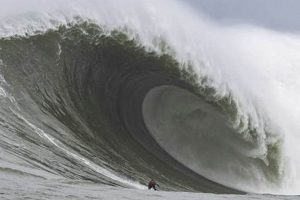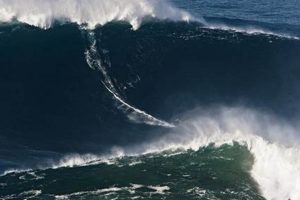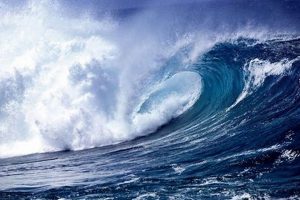The pursuit of riding the ocean’s most formidable swells represents the pinnacle of big wave surfing. This activity involves skilled athletes navigating immense bodies of water, often exceeding heights of 50 feet, with specialized equipment and rigorous training. Nazare, Portugal, and Jaws (Peahi), Hawaii, are examples of locations known for producing these extraordinary wave conditions.
Engaging with extreme wave faces requires not only exceptional physical prowess and technical skill but also profound knowledge of oceanography, meteorology, and risk management. The historical evolution of this sport demonstrates a continuous push toward innovation in board design, tow-in techniques, and safety protocols. Successful negotiation of these massive formations garners significant recognition and pushes the boundaries of human capability in the aquatic realm.
The following sections will delve into the specific locations known for their unparalleled surf conditions, the essential equipment employed, and the rigorous training regimens undertaken by those who dare to challenge the ocean’s most powerful expressions.
Strategies for Approaching Large Wave Riding
Successfully navigating exceptionally large waves requires a multifaceted approach encompassing physical preparedness, mental fortitude, and technical proficiency. The following guidelines emphasize critical considerations for individuals seeking to engage in this challenging pursuit.
Tip 1: Prioritize Comprehensive Training: Consistent training regimens should incorporate cardiovascular conditioning, strength training, and breath-hold exercises. These preparations are essential for withstanding the physical demands and potential underwater duress inherent in large wave surfing.
Tip 2: Master Essential Safety Protocols: Proficiency in water rescue techniques, including the use of inflatable personal flotation devices and communication protocols, is paramount. Familiarization with local emergency services and response procedures is also crucial.
Tip 3: Develop Expert Ocean Knowledge: A deep understanding of wave dynamics, tidal influences, and prevailing weather patterns is indispensable. This knowledge enables informed decision-making regarding wave selection and potential hazards.
Tip 4: Utilize Specialized Equipment: The appropriate surfboard selection, coupled with reliable tow-in systems and personal protective gear, is critical for both performance and safety. Regular equipment inspection and maintenance are necessary to ensure optimal functionality.
Tip 5: Cultivate a Disciplined Mental Approach: Maintaining composure under pressure and exercising sound judgment are essential for mitigating risk. A clear understanding of personal limitations and the ability to make calculated decisions are paramount.
Tip 6: Establish a Reliable Support Network: Surrounding oneself with experienced water safety personnel, skilled boat operators, and trusted advisors is crucial. Collaborative communication and shared decision-making enhance overall safety and preparedness.
Tip 7: Begin with Gradual Progression: Incremental exposure to progressively larger waves, under controlled conditions, facilitates skill development and confidence building. Avoid premature attempts at challenging conditions that exceed current abilities.
Adherence to these guidelines will contribute to a safer and more fulfilling experience within the realm of extreme wave riding. Comprehensive preparation, coupled with sound judgment, remains the cornerstone of success and survival in this challenging discipline.
The subsequent sections will address specific locations where these principles can be applied, alongside further considerations for optimal performance in extreme surfing environments.
1. Location
Geographic location plays a deterministic role in the formation and characteristics of the largest surfable waves. Specific coastal and oceanic features, influenced by meteorological patterns and bathymetry, create the conditions necessary for the generation of extreme wave events.
- Bathymetry and Wave Focusing
The underwater topography, or bathymetry, significantly impacts wave behavior. Submarine canyons, reefs, and sudden changes in depth can refract and focus wave energy, leading to amplified wave heights. For instance, Nazar, Portugal, benefits from a deep submarine canyon that channels swell energy towards Praia do Norte, resulting in extraordinarily large waves.
- Prevailing Weather Systems
Consistent and powerful weather systems are primary drivers of large wave generation. Intense low-pressure systems, such as those occurring in the North Atlantic and Pacific Oceans, produce strong winds that generate significant swell energy. These swells can travel vast distances and ultimately break along coastlines capable of supporting large surf.
- Coastal Orientation and Exposure
The orientation of a coastline relative to prevailing swell directions dictates the size and consistency of waves. Coastlines directly exposed to open ocean swells, without significant sheltering from landmasses, tend to receive larger and more frequent wave events. Examples include the North Shore of Oahu, Hawaii, and certain stretches of the Californian coast.
- Tidal Influence and Wave Amplification
Tidal fluctuations can exacerbate wave heights in specific locations. High tides, particularly during spring tides, can increase water depth and allow larger waves to break closer to shore. Conversely, low tides may expose shallow reefs and create hazardous conditions, limiting surfable wave events.
The interplay between bathymetry, weather patterns, coastal orientation, and tidal influences creates the unique conditions that define locations suitable for extreme wave surfing. Recognition of these factors is essential for both identifying potential big wave locations and understanding the specific hazards inherent to each environment. Further research into regional oceanography and meteorology provides a more detailed understanding of wave dynamics at these sites.
2. Equipment
The successful and safe negotiation of the ocean’s largest waves necessitates specialized equipment designed to withstand extreme forces and enhance rider capabilities. The following outlines key components critical for this endeavor.
- Surfboards
Big wave surfboards differ significantly from standard surfboards. They are typically longer (10-12 feet or more), thicker, and heavier to provide increased paddling speed, stability, and the ability to handle the tremendous energy of large waves. Construction often involves multiple layers of fiberglass and epoxy resin reinforced with carbon fiber for increased strength and durability. Tow-in boards, used for accessing waves too large to paddle into, are even more specialized, incorporating foot straps for enhanced control.
- Personal Flotation Devices (PFDs)
Inflatable PFDs, often integrated into wetsuits, are essential safety equipment. These devices provide rapid buoyancy in the event of a wipeout, mitigating the risk of prolonged underwater submersion. CO2 cartridges trigger inflation, and many models include integrated communication systems, allowing surfers to signal for assistance.
- Wetsuits and Protective Gear
Thick wetsuits (5-6mm) provide thermal insulation in cold water conditions, crucial for maintaining physical and mental performance during extended sessions. Impact vests, helmets, and reinforced gloves offer protection against collisions with the surfboard or submerged objects. Eye protection, such as specialized sunglasses or goggles, shields against glare and spray.
- Tow-In Systems
For waves exceeding paddle-in capabilities, tow-in surfing employs a personal watercraft (PWC) to propel the surfer into the wave. This requires a skilled PWC operator and a robust tow rope system. Communication between the surfer and driver is paramount for safe and effective wave entry.
The selection and proper maintenance of specialized equipment is a critical aspect of big wave surfing. Each component contributes to both performance and safety, mitigating the inherent risks associated with riding the ocean’s most powerful swells. Without appropriate gear, navigating these waves is not feasible, and the probability of serious injury or fatality increases significantly.
3. Skill
The ability to successfully engage with the ocean’s most formidable waves is inextricably linked to a well-developed skillset. Riding the largest waves is not a matter of chance but rather the culmination of years of dedicated training, experience, and a deep understanding of ocean dynamics. Cause and effect are clearly evident: without sufficient skill, attempting to surf large waves invariably leads to dangerous situations. The importance of skill manifests in the surfer’s ability to accurately assess wave conditions, execute precise maneuvers, and react effectively to rapidly changing circumstances. Consider, for example, the late Mark Foo, a renowned big-wave surfer, whose death at Mavericks underscored the necessity of preparedness and experience, even for seasoned professionals.
The practical significance of this understanding extends beyond individual safety. Skill informs every decision, from selecting the appropriate equipment and choosing optimal positioning in the lineup to executing critical maneuvers like bottom turns and cutbacks. Furthermore, skilled big-wave surfers contribute significantly to the advancement of the sport through innovation in equipment design, development of safety protocols, and sharing of knowledge. For instance, Laird Hamilton’s pioneering work in tow-in surfing demonstrated the power of skill combined with technological advancement to push the boundaries of what is possible in large wave riding.
In summary, skill is a non-negotiable prerequisite for safely and successfully confronting the ocean’s largest waves. It is the foundation upon which all other aspects of big-wave surfing equipment selection, risk assessment, and safety procedures are built. While the allure of riding massive swells may be strong, the reality is that only those possessing the requisite skills, honed through years of dedication and experience, can truly hope to challenge these forces of nature and emerge unscathed.
4. Risk
Engagement with exceptionally large waves intrinsically involves substantial risk. The immense power and unpredictable nature of these oceanic forces necessitate meticulous consideration and management of potential hazards.
- Drowning
The primary risk associated with big wave surfing is drowning. Prolonged submersion following a wipeout, due to wave hold-down, can lead to oxygen deprivation and subsequent unconsciousness. The sheer volume of water associated with large waves, coupled with the potential for multiple consecutive waves, significantly increases this risk. The case of Sion Milosky at Mavericks serves as a stark reminder of the fatal consequences of wave hold-downs.
- Impact Injuries
The force of impact with the water’s surface or submerged objects during a wipeout can result in serious injuries, including concussions, broken bones, and internal trauma. The high speeds attained while riding large waves amplify the severity of these impacts. The presence of shallow reefs or rocky bottoms further exacerbates this risk. Fractures, dislocations, and head trauma are relatively common occurrences in big wave surfing.
- Equipment Failure
The extreme forces exerted on surfboards and other equipment can lead to catastrophic failure. Broken leashes, snapped boards, or malfunctioning inflatable vests can compromise a surfer’s safety and increase the likelihood of drowning or injury. Regular equipment inspection and maintenance are crucial for mitigating this risk.
- Marine Life Encounters
The presence of potentially dangerous marine life, such as sharks, adds another layer of risk to big wave surfing. Encounters with sharks, although relatively infrequent, can result in serious injury or death. The remoteness of many big wave surf locations can also delay medical response times in the event of a marine animal attack.
The interplay between environmental hazards, equipment reliability, and individual surfer preparedness significantly influences the overall risk profile of big wave surfing. Effective risk management strategies, including thorough pre-surf assessments, the use of appropriate safety equipment, and the presence of experienced water safety personnel, are essential for minimizing the potential for adverse outcomes. However, despite these precautions, the inherent risks associated with challenging the ocean’s largest waves remain substantial.
5. Safety
The pursuit of riding the ocean’s largest waves mandates an unwavering commitment to safety protocols, representing not merely an adjunct but an integrated, indispensable element of the activity. The connection between safety and successfully navigating extreme wave conditions is fundamentally causative: inadequate safety measures directly increase the probability of severe injury or fatality. The inherent dangers presented by immense wave energy, potential for prolonged underwater submersion, and remote locations amplify the consequences of any lapse in safety preparedness. Consider, for example, the established procedures at locations like Jaws (Peahi) in Hawaii, where jet ski support, trained lifeguards, and comprehensive communication systems are standard practice. These measures are not discretionary but are considered essential to mitigate the risks inherent in confronting such powerful oceanic forces.
Effective safety protocols encompass a spectrum of considerations, including comprehensive pre-surf assessments, the utilization of appropriate safety equipment, and the presence of experienced water safety personnel. Pre-surf assessments involve meticulous evaluation of wave conditions, weather patterns, tidal influences, and potential hazards such as submerged reefs or strong currents. Appropriate safety equipment includes specialized surfboards designed for extreme conditions, personal flotation devices capable of rapid inflation, and impact-resistant protective gear. The presence of qualified water safety teams, equipped with jet skis and advanced medical training, provides immediate rescue capabilities in the event of a wipeout or other emergency. The historical record of big wave surfing contains numerous instances where the swift and effective response of water safety teams has averted potentially fatal outcomes, underscoring the practical significance of these resources.
In conclusion, the relationship between safety and big wave surfing is symbiotic and critical. Safety is not merely a supplementary consideration but rather an intrinsic component of any successful endeavor to ride the ocean’s largest waves. A comprehensive approach to safety, encompassing thorough pre-surf assessments, specialized equipment, and the presence of trained professionals, represents the most effective means of mitigating the inherent risks and ensuring the well-being of those who challenge the ocean’s most formidable expressions. The continuous evolution and refinement of safety protocols remain essential for the continued advancement of this challenging and potentially dangerous activity.
Frequently Asked Questions
The following addresses common inquiries regarding the challenges, equipment, and safety aspects associated with riding exceptionally large waves.
Question 1: What wave height is considered to be “big wave surfing?”
While subjective, a general consensus identifies waves exceeding 20 feet in height as constituting big wave surfing. However, the true measure lies not only in height but also in the wave’s power and overall conditions.
Question 2: Where are some of the most renowned locations for big wave surfing?
Notable locations include Nazar, Portugal; Jaws (Peahi), Hawaii; Mavericks, California; and Teahupo’o, Tahiti. Each location presents distinct wave characteristics and challenges.
Question 3: What specific equipment is essential for engaging in big wave surfing?
Essential equipment includes specialized surfboards (often 10 feet or longer), personal flotation devices (PFDs), thick wetsuits for thermal insulation, and tow-in systems utilizing personal watercraft (PWCs) for accessing extremely large waves.
Question 4: What types of training are necessary to prepare for big wave surfing?
Comprehensive training regimens encompass cardiovascular conditioning, strength training, breath-hold exercises, and extensive experience in varied wave conditions. Mental preparedness and risk assessment skills are also critical.
Question 5: What are the primary risks associated with big wave surfing?
The primary risks include drowning due to prolonged submersion, impact injuries from collisions with the water or submerged objects, equipment failure, and potential encounters with marine predators.
Question 6: What safety measures are crucial for mitigating risk in big wave surfing?
Essential safety measures involve pre-surf assessments of wave conditions, the presence of experienced water safety personnel equipped with PWCs, utilization of appropriate safety equipment, and adherence to established communication protocols.
The information presented underscores the significant commitment, training, and risk mitigation strategies required for safe and successful engagement with exceptionally large waves.
The following sections will provide additional resources and further explore related topics within the realm of extreme water sports.
Conclusion
The preceding analysis has detailed the multifaceted aspects of the biggest waves to surf, encompassing geographical influences, equipment specifications, requisite skill sets, and inherent risks. The emphasis has remained consistently on the critical role of safety protocols in mitigating potential hazards and ensuring the well-being of those who pursue this demanding activity. Successfully navigating these extreme conditions demands a comprehensive understanding of ocean dynamics, meticulous preparation, and a profound respect for the power of the natural environment.
The future of big wave surfing will undoubtedly see continued advancements in equipment technology, refined training methodologies, and further development of safety practices. However, the fundamental challenge of confronting the ocean’s most formidable swells will remain a test of human skill, resilience, and a calculated acceptance of inherent risk. The pursuit requires a steadfast commitment to responsible engagement and a recognition of the profound consequences of underestimation or inadequate preparation. The pursuit of conquering the biggest waves to surf continues, but only through knowledge, respect, and unwavering preparedness.







